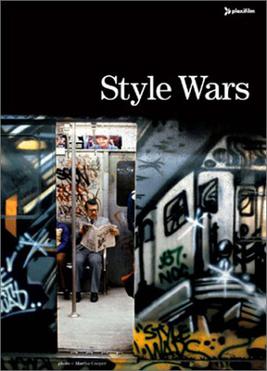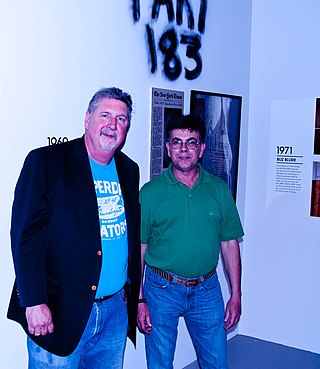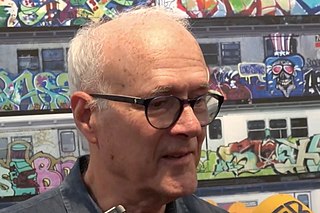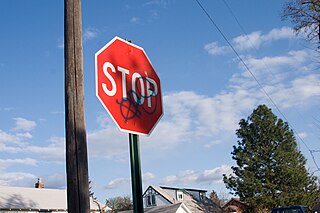Related Research Articles

Graffiti is writing or drawings made on a wall or other surface, usually without permission and within public view. Graffiti ranges from simple written "monikers" to elaborate wall paintings, and has existed since ancient times, with examples dating back to ancient Egypt, ancient Greece, and the Roman Empire.

Fred Brathwaite, more popularly known as Fab 5 Freddy, is an American visual artist, filmmaker, and hip hop pioneer. He is considered one of the architects of the street art movement. Freddy emerged in New York's downtown underground creative scene in the late 1970s as a graffiti artist. He was the bridge between the burgeoning uptown rap scene and the downtown No Wave art scene. He gained wider recognition in 1981 when Debbie Harry rapped on the Blondie song "Rapture" that "Fab 5 Freddy told me everybody's fly." In the late 1980s, Freddy became the first host of the groundbreaking hip-hop music video show Yo! MTV Raps.

Style Wars is an American 1983 documentary film on hip hop culture, directed by Tony Silver and produced in collaboration with Henry Chalfant. The film has an emphasis on graffiti, although bboying and rapping are covered to a lesser extent. The film was originally aired on the television network PBS and was subsequently shown in several film festivals to much acclaim, including the Vancouver Film Festival. It also won the Grand Jury Prize: Documentary at the Sundance Film Festival.

Leonard Hilton McGurr, known as Futura, and formerly known as Futura 2000, is an American contemporary artist and former graffiti artist.

TAKI 183 is the "tag" of a Greek-American graffitist who was active during the late 1960s and early 1970s in New York City. The graffitist, whose given name is Demetrios, has never revealed his full name.

Henry Chalfant is an American photographer and videographer most notable for his work on graffiti, breakdance, and hip hop culture.

Street art is visual art created in public locations for public visibility. It has been associated with the terms "independent art", "post-graffiti", "neo-graffiti" and guerrilla art.
George Lee Quiñones is a Puerto Rican artist and actor. Quiñones rose to prominence by creating massive New York City subway car graffiti that carried his moniker "LEE". His style is rooted in popular culture and often with political messages.

Lady Pink, born Sandra Fabara, is an Ecuadorian-born American graffiti and mural artist, active in New York City.

Martha Cooper is an American photojournalist. She worked as a staff photographer for the New York Post during the 1970s. She is best known for documenting the New York City graffiti scene of the 1970s and 1980s.

Dean Stockton, better known by his alias D*Face, is an English multimedia street artist who uses spray paint, stickers, posters, and stencils.

Stephen J. Powers is an American contemporary artist and muralist. He is also known by the name ESPO, and Steve Powers. He lives in New York City.
SJK 171, aka Steve the Greek is a New York City graffiti artist who was active during the late 1960s and 1970s. A native of Washington Heights, he was a founding member of United Graffiti Artists, one of the first professional graffiti collectives.
SAMO is a graffiti tag originally used on the streets of New York City from 1978 to 1980. The tag, written with a copyright symbol as "SAMO©", and pronounced Same-Oh, is primarily associated with the artist Jean-Michel Basquiat, but was originally developed as a collaboration between Basquiat and Al Diaz.
Subway Art is a collaborative book by Martha Cooper and Henry Chalfant, which documents the early history of the New York City graffiti movement. Originally published in 1984, the book has been described as a "landmark photographic history".
George Ibañez, also known as “Crime79”, is a New York City-based graffiti artist. His style is rooted in popular culture and often with political messages.

Graffiti are writing or drawings scribbled, scratched, or sprayed illicitly on a wall or other surface in a public place. Graffiti ranges from simple written words to elaborate wall paintings. Graffiti, consisting of the defacement of public spaces and buildings, remains a nuisance issue for cities.

Graffiti in New York City has had a substantial local, national, and international influence.
Spraycan Art is the first book that documented the initial stages of the worldwide spread of New York City Subway graffiti style and subculture. Authored by Henry Chalfant and James Prigoff and published by Thames & Hudson on September 1, 1987.

James Prigoff was an American photographer, author, and lecturer focusing on public murals, graffiti, and spraycan art. He has traveled extensively throughout the world documenting these art forms, and his personal archive of 100,000 slides may well be the most comprehensive of any individual mural and graffiti documentarian.
References
- ↑ Vivien Raynor (March 3, 1991). "ART; 'Hip Hop' Moves Closer to Respectability". The New York Times . Retrieved January 1, 2020.
- ↑ Penelope Green (April 10, 2005). "Using Graffiti as a Decorating Tool". The New York Times . Retrieved January 1, 2020.
- ↑ Gottlieb, Lisa. (2008). Graffiti art styles : a classification system and theoretical analysis. Jefferson, N.C.: McFarland. pp. 38–39. ISBN 978-0-7864-3436-7. OCLC 228608106.
- ↑ Miller, Ivor (July 1993). "Guerrilla artists of New York City". Race & Class. 35 (1): 27–40. doi:10.1177/030639689303500104. ISSN 0306-3968. S2CID 144157165.
- ↑ Castleman, Craig. (1982). Getting up : subway graffiti in New York. Cambridge, Mass.: MIT Press. ISBN 0-262-03089-6. OCLC 8476629.
- 1 2 Jordan Riefe (June 21, 2018). ""Beyond The Streets" Harkens To Graffiti's Roots In Diversity". LA Weekly . Retrieved January 1, 2020.
- ↑ Kristen Tauer (December 5, 2019). "Art Basel Miami Beach 2019: Museum of Graffiti Opens in Wynwood". WWD . Retrieved January 5, 2020.
- 1 2 Jon Caramonica (December 20, 2019). "Phase 2, an Aerosol Art Innovator, Is Dead at 64". The New York Times . Retrieved January 1, 2020.
- ↑ Peter Schjeldahl (September 16, 1973). "Graffiti Goes Legit—But the 'Show-Off Ebullience' Remains". The New York Times . Retrieved January 1, 2020.
- ↑ Ula Ilnytzky (February 3, 2014). "Graffiti art highlighted in NYC exhibition". Associated Press . Retrieved January 1, 2020.
- ↑ Kevin Jackson (May 20, 2001). "Reading graffiti". Prospect . Retrieved January 1, 2020.
- ↑ Cori Anderson (February 13, 2017). "MCA-Denver Debuts Its Biggest Opening With Gritty And Uncensored Exhibit". 303 Magazine. Retrieved January 1, 2020.
- ↑ Chalfant, H. 1992. “No One Is in Control.” Pp. 4-11 in Vandalism: Research, Prevention and Social Policy, edited by H. H. Chistensen , D. R. Johnson , and M. H. Brookes . Portland, OR: Department of Agriculture Forest Service.Christensen, H.H.; Johnson, D.R.; Brookes, M.H. (1992). Vandalism: research, prevention, and social policy (Report). United States Forest Service. doi:10.2737/PNW-GTR-293. hdl: 2027/umn.31951d029749434 . S2CID 158966695.
- 1 2 Liz Ohanesian (May 22, 2018). "Exploring The Evolution Of Street Art". GOOD Magazine. Retrieved January 1, 2020.
- ↑ Thomas, Sean P. "Celebrating Street Art in a Chinatown Warehouse". Los Angeles Downtown News - The Voice of Downtown Los Angeles. Retrieved 2019-12-29.